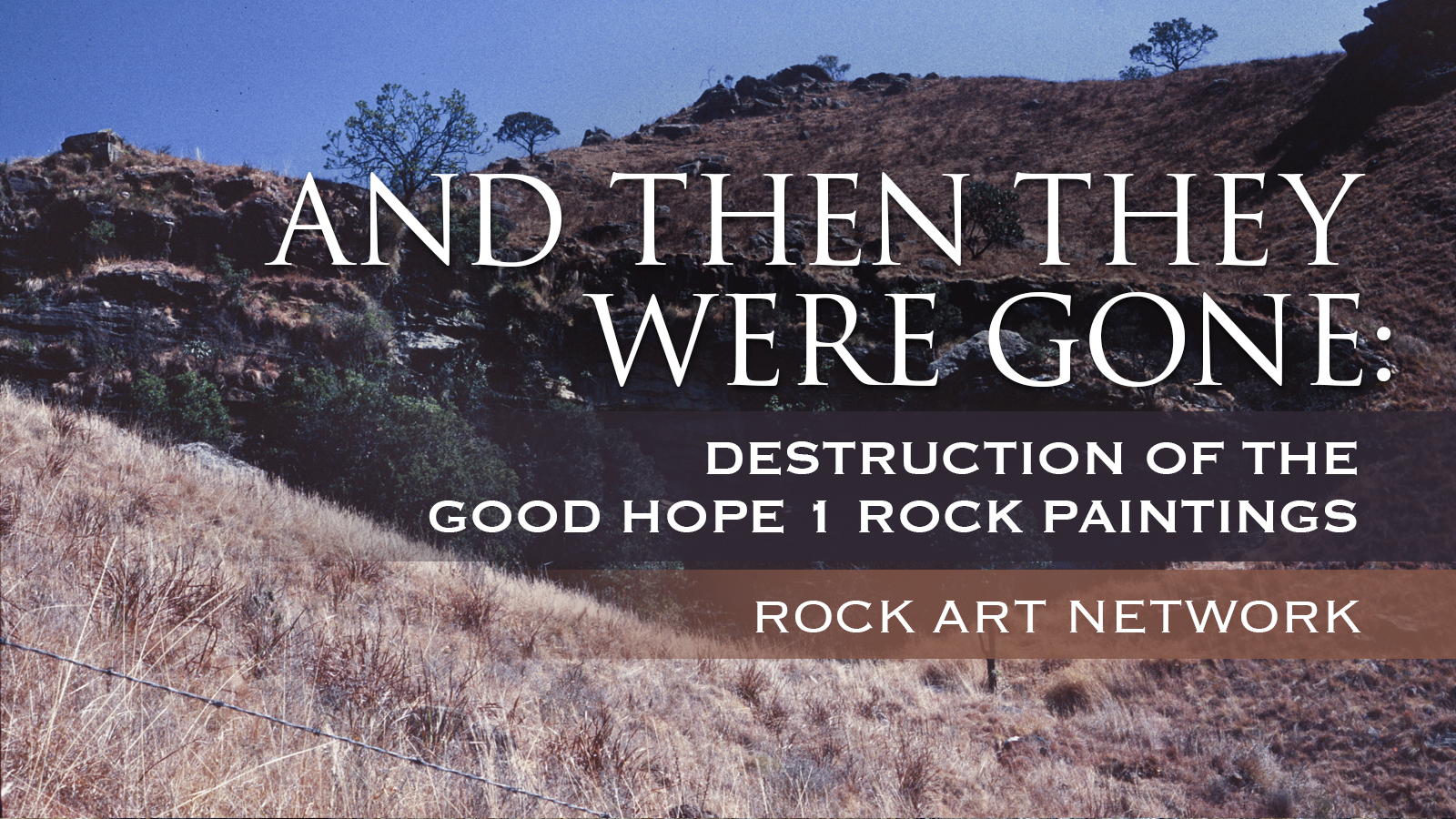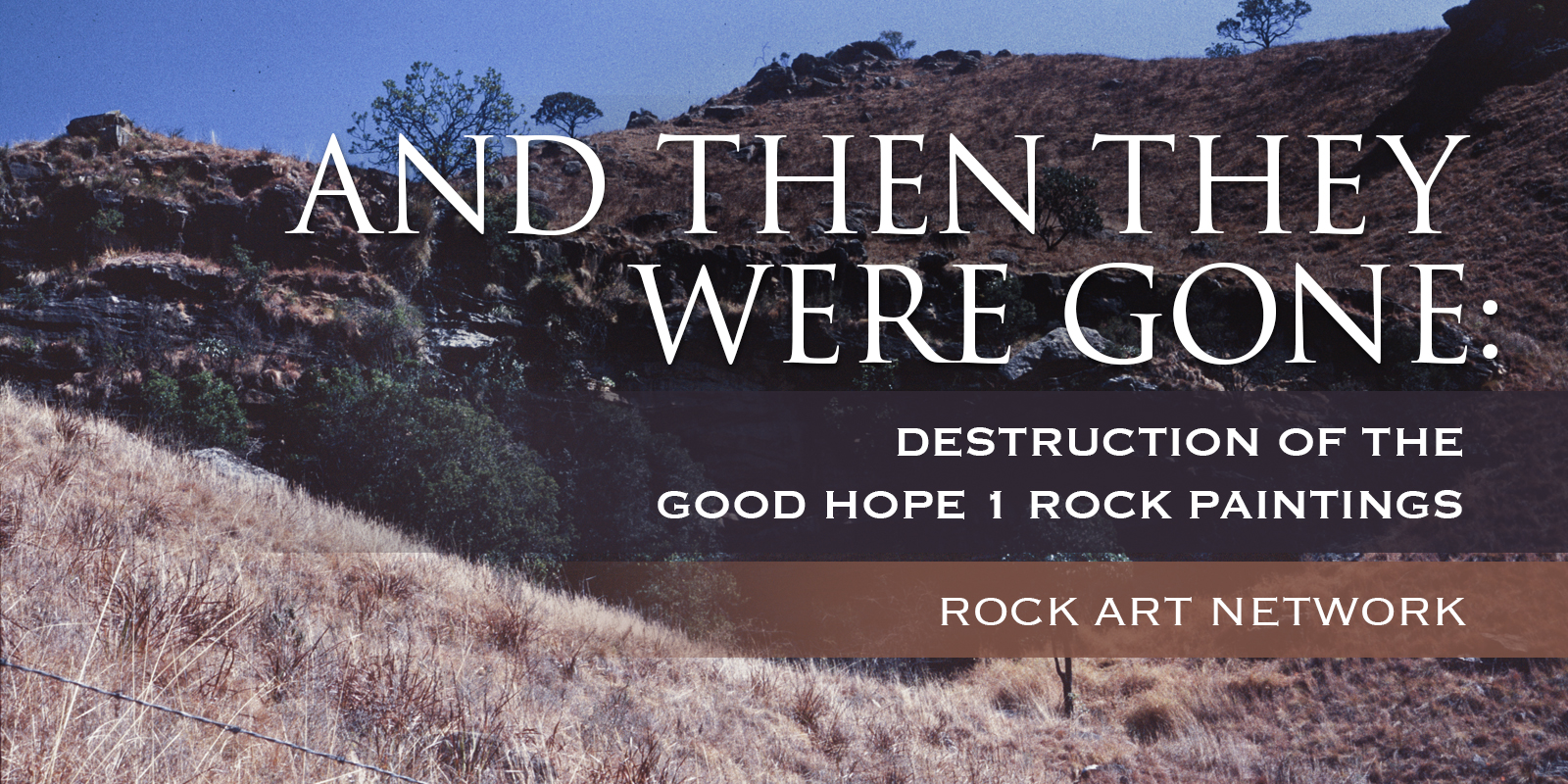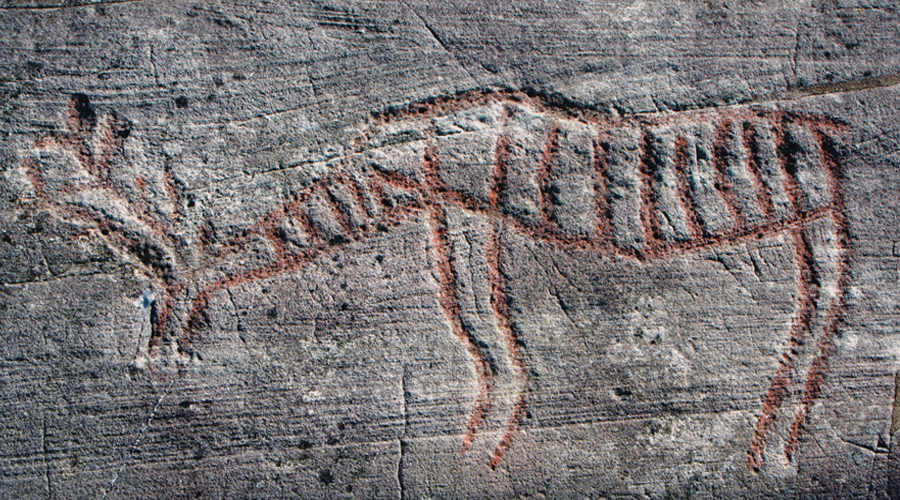


Aron Mazel
Newcastle University and University of the Witwatersrand
On 19 August 1980, I visited Good Hope 1 (Figure 1), in the southern uKhahlamba-Drakensberg mountains (South Africa) for the first time. It was about the 250th rock art site I had recorded in the project ‘A survey of the Rock Art in the Natal Drakensberg’. The project’s overarching aim was to record accurate and thorough evidence of the paintings and related archaeological material in the mountain range to underpin management planning (Mazel 1981, 2018). Although I was based at the Natal Museum (now KwaZulu-Natal Museum), the project was funded by the Directorate of Forestry, which managed most of the mountains at the time. Even though I had already recorded many rock art sites, I was not prepared for what I encountered at Good Hope 1. I anticipated seeing the paintings which Patricia Vinnicombe (1976) had published only four years previously in People of the Eland. I was aware, from the book, that some of paintings had been deteriorating over the years but imagine my dismay when I discovered that some of the paintings that Vinnicombe had published no longer existed. Until then, I had not experienced a situation where it was so evident that paintings had been completely obliterated.
Having familiarised myself with Vinnicombe’s published redrawings of the Good Hope 1 paintings before my visit, I knew that some of the paintings would be in bad shape. This is clearly reflected in the scene focused on here, which Vinnicombe highlighted as a problem in People of the Eland by including a photograph of it published by Anderson in 1907 (Figure 2) and her 1958 tracing (Figure 2) where she commented that ‘a considerable amount of deterioration to have taken place, although the group was still quite recognisable’ (Vinnicombe 1976, 121). Ten years later, in 1968, she retraced the same scene noting ‘the paintings were so fragmentary as to be barely discerned’ (Figure 2; Vinnicombe 1976, 121). When I visited Good Hope 1, this scene was no longer there. Another example of the complete loss of paintings at the site, is that Vinnicombe (1976, 86) had noted the presence of three fish paintings, none of which I could record in 1980 because again they were not there. Vinnicombe (1976, 221) explains that the paintings ‘suffered much deterioration, partly due to the soft sandstone on which they are executed, and partly due to the repeated wetting and fingering by the many visitors from the nearby Sani Pass Hotel.’ The hotel’s practice of directing people to the site, which is across from their golf course, without adequate guidelines, was still in practice when I visited. While in the site, I showed a disappointed group of people the paintings that remained because they were struggling to see them.
The next day, 20 August 1980, I recorded Good Hope 2. That night, I noted in my daily journal: ‘It is interesting that while Good Hope 1 is very badly vandalised Good Hope 2 which is only 300m away and on a path has no vandalism at all.’ At Good Hope 1, I recorded 60 paintings whereas at Good Hope 2, I recorded 219 paintings. I suspect that originally Good Hope 1 had more paintings than Good Hope 2. This inference is based not only on the destruction wreaked on the Good Hope 1 paintings by visitors, but also because it is a considerably larger site (90m x 9m; Cable et al. 1980) than Good Hope 2 (25m x 3m; my recording), although I appreciate that we cannot assume that there is relationship between the size of a site and the number of paintings people made in them. Also, worth noting is that the hunter-gatherer occupation of Good Hope 1 extended back to 8000 years ago and it appears that their occupation was most extensive around 2000 years ago (Cable et al. 1980), during which time there appears to have been an upsurge in hunter-gatherers making paintings in uKhahlamba-Drakensberg (Mazel 2009). There may have been another upsurge of painting in the 1800s, and there are paintings belonging to this period in both sites (Figure 3 & Figure 4). It would seem that visitors were so disappointed by the Good Hope 1 paintings, they didn’t think it worthwhile visiting Good Hope 2, and the paintings were spared vandalism! Just as well as it contains an interesting array of images, including an eland lying on its back (Figure 5) and two animal heads with no bodies (Figure 6).
Jeff Guy and Justine Wintjes (2009) have ‘restored’ the obliterated scene digitally using Anderson’s photograph and Vinnicombe’s redrawings (Figure 7). Without archival imagery this would not have been possible. We know that the erosional forces, which created the rock shelters and overhangs are ongoing, probably now exacerbated by climate change and, therefore, the paintings will eventually erode away. Nonetheless, many of the paintings in the mountain range have lasted for 2000 years and some possibly for over 3000 years (Mazel & Watchman 2004). It is, therefore, hoped they would last well into the future if not interfered with by people.
At Good Hope 1, we have witnessed the rapid loss of paintings at the hands of people who either did not know, or care, about how to behave when viewing paintings. It begs the question whether similar behaviours would be tolerated in an art gallery. The responsibility of educating the public about the fragility of rock art continues to be a challenge for those of us concerned with its curation and safeguarding. This seminal moment occurred early on in my career. Emphasising the vulnerability of rock art, particularly at the hands of people, made me realise early on the importance of public education as captured in this statement: ‘Thus it is not stricter laws that are desired but rather the understanding and support of the general public’ (Mazel 1982, 7).
Anderson, W. 1907. Third and final report of the geological survey of Natal and Zululand. London: West, Newman & Co. (Note: A photograph used her was taken at Good Hope 1 and published in 1907 by Anderson was reproduced in Vinnicombe, 1976).
Cable, J H C, Scott, K & Carter, P L 1980 Excavations at Good Hope Shelter, Underberg District, Natal, Annals of the Natal Museum 24 (1), 1-34.’ between ‘Anderson’ and ‘Guy’.
Guy, J. and Wintjes, J. 2009. Restoring Good Hope: rock art in the age of digital reproduction Southern African Humanities 21: 63–84.
Mazel, A.D. 1982. Principles for conserving the archaeological resources of the Natal Drakensberg. South African Archaeological Bulletin 37: 7-15.
Mazel, A.D. 2009. Unsettled times: shaded polychrome paintings and hunter-gatherer history in the southeastern mountains of southern Africa. Southern African Humanities 21: 85-115.
Mazel, A.D. 2018. Reflecting back: 40 years since the ‘A survey of the Rock Art in the Natal Drakensberg’ project (1978-1981). The Digging Stick. 35 (1): 1-5. (Republished on 29 September 2020: Reflecting Back: 40 Years Since ‘A Survey of the Rock Art in the Natal Drakensberg’ Project).
Mazel, A.D. & Watchman, A.L. 2003. The dating of rock paintings in the Natal Drakensberg and the Biggarsberg, KwaZulu-Natal, South Africa. Southern African Humanities 15: 59-73.
Vinnicombe, P. 1976. People of the Eland. Pietermaritzburg: University of Natal Press.
→ Members and affiliated institutions of the Rock Art Network
by
George Nash
5/09/2024 Recent Articles
→ Sigubudu: Paintings of people with guns in the northern uKhahlamba-Drakensberg
by Aron Mazel
22/07/2024
by Richard Kuba
13/06/2024
by Meenakshi Dubey-Pathak
8/03/2024
by Rock Art Network
6/02/2024
by Rock Art Network
14/12/2023
by Sam Challis
5/12/2023
by Aron Mazel
30/11/2023
by Sam Challis
21/11/2023
by Sam Challis
15/11/2023
by Sam Challis
10/11/2023
by Rock Art Network
6/11/2023
by Rock Art Network
3/11/2023
by Aron Mazel
2/11/2023
by Meenakshi Dubey-Pathak
26/09/2023
by Paul Taçon
24/08/2023
by Aron Mazel
13/06/2023
by Paul Taçon
5/06/2023
by Paul Taçon
15/03/2023
by George Nash
14/03/2023
by Noel Hidalgo Tan
10/02/2023
by George Nash
01/02/2023
by Meenakshi Dubey-Pathak, Pilar Fatás Monforte
29/11/2022
by Aron Mazel, George Nash
21/09/2022
by Paul S.C. Taçon, Sally K. May, Ursula K. Frederick, Jo McDonald
07/07/2022
by Meenakshi Dubey-Pathak
26/07/2022
by Paul Taçon
20/07/2022
by David Coulson
16 June 2022
by Paul Taçon
25 April 2022
by Noel Hidalgo Tan
20 April 2022
by Meenakshi Dubey-Pathak
14 March 2022
by Carolyn Boyd & Pilar Fatás
02 March 2022
by David Coulson
07 February 2022
by Johannes H. N. Loubser
06 February 2022
by Meenakshi Dubey-Pathak
05 February 2022
by Aron Mazel
28 January 2022
by Aron Mazel
8 September 2021
by David Coulson
17 August 2021
by Ffion Reynolds
21 June 2021


by Aron Mazel
22/07/2024
by Richard Kuba
13/06/2024
by Meenakshi Dubey-Pathak
8/03/2024
by Rock Art Network
6/02/2024
by Rock Art Network
14/12/2023
by Sam Challis
5/12/2023
by Aron Mazel
30/11/2023
by Sam Challis
21/11/2023
by Sam Challis
15/11/2023
by Sam Challis
10/11/2023
by Rock Art Network
6/11/2023
by Rock Art Network
3/11/2023
by Aron Mazel
2/11/2023
by Meenakshi Dubey-Pathak
26/09/2023
by Paul Taçon
24/08/2023
by Aron Mazel
13/06/2023
by Paul Taçon
5/06/2023
by Paul Taçon
15/03/2023
by George Nash
14/03/2023
by Noel Hidalgo Tan
10/02/2023
by George Nash
01/02/2023
by Meenakshi Dubey-Pathak, Pilar Fatás Monforte
29/11/2022
by Aron Mazel, George Nash
21/09/2022
by Paul S.C. Taçon, Sally K. May, Ursula K. Frederick, Jo McDonald
07/07/2022
by Meenakshi Dubey-Pathak
26/07/2022
by Paul Taçon
20/07/2022
by David Coulson
16 June 2022
by Paul Taçon
25 April 2022
by Noel Hidalgo Tan
20 April 2022
by Meenakshi Dubey-Pathak
14 March 2022
by Carolyn Boyd & Pilar Fatás
02 March 2022
by David Coulson
07 February 2022
by Johannes H. N. Loubser
06 February 2022
by Meenakshi Dubey-Pathak
05 February 2022
by Aron Mazel
28 January 2022
by Aron Mazel
8 September 2021
by David Coulson
17 August 2021
by Ffion Reynolds
21 June 2021
Friend of the Foundation


by Aron Mazel
22/07/2024
by Richard Kuba
13/06/2024
by Meenakshi Dubey-Pathak
8/03/2024
by Rock Art Network
6/02/2024
by Rock Art Network
14/12/2023
by Sam Challis
5/12/2023
by Aron Mazel
30/11/2023
by Sam Challis
21/11/2023
by Sam Challis
15/11/2023
by Sam Challis
10/11/2023
by Rock Art Network
6/11/2023
by Rock Art Network
3/11/2023
by Aron Mazel
2/11/2023
by Meenakshi Dubey-Pathak
26/09/2023
by Paul Taçon
24/08/2023
by Aron Mazel
13/06/2023
by Paul Taçon
5/06/2023
by Paul Taçon
15/03/2023
by George Nash
14/03/2023
by Noel Hidalgo Tan
10/02/2023
by George Nash
01/02/2023
by Meenakshi Dubey-Pathak, Pilar Fatás Monforte
29/11/2022
by Aron Mazel, George Nash
21/09/2022
by Paul S.C. Taçon, Sally K. May, Ursula K. Frederick, Jo McDonald
07/07/2022
by Meenakshi Dubey-Pathak
26/07/2022
by Paul Taçon
20/07/2022
by David Coulson
16 June 2022
by Paul Taçon
25 April 2022
by Noel Hidalgo Tan
20 April 2022
by Meenakshi Dubey-Pathak
14 March 2022
by Carolyn Boyd & Pilar Fatás
02 March 2022
by David Coulson
07 February 2022
by Johannes H. N. Loubser
06 February 2022
by Meenakshi Dubey-Pathak
05 February 2022
by Aron Mazel
28 January 2022
by Aron Mazel
8 September 2021
by David Coulson
17 August 2021
by Ffion Reynolds
21 June 2021
Friend of the Foundation






















